| Metric | Value |
|---|---|
| Functional Printing Market Estimated Value in (2025 E) | USD 36.1 billion |
| Functional Printing Market Forecast Value in (2035 F) | USD 210.3 billion |
| Forecast CAGR (2025 to 2035) | 19.3% |
The functional printing market is witnessing strong growth, driven by the rising demand for advanced printing solutions in electronics, biomedical devices, packaging, and smart displays. Increasing adoption of printed electronics, wearable sensors, and flexible devices is creating significant opportunities for materials and technologies capable of delivering precise functionality and performance. Investments in research and development are facilitating innovations in functional inks, printing methods, and substrate compatibility, enhancing process efficiency and end-product quality.
The trend toward miniaturization and customization in electronics, coupled with growing industrial automation, is further supporting market expansion. As companies focus on reducing production costs while maintaining high performance, functional printing solutions are being preferred for their versatility and scalability.
Regulatory emphasis on sustainable manufacturing and low-waste processes is also influencing market dynamics, favoring materials and technologies that align with environmental standards With increasing deployment in applications such as displays, sensors, and energy devices, the functional printing market is expected to maintain sustained growth over the coming decade, supported by continuous technological advancements and broader adoption across industries.
The functional printing market is segmented by material, printing technology, application, and geographic regions. By material, functional printing market is divided into Functional Printing Ink and Functional Printing Substrate. In terms of printing technology, functional printing market is classified into Functional Inkjet Printing, Functional Screen Printing, Functional Gravure Printing, and Functional Flexography. Based on application, functional printing market is segmented into Functional Printing for Display, Functional Printing for Sensors, Functional Printing for Batteries, Functional Printing for RFID Tags, Functional Printing for Lighting, and Functional Printing for Photovoltaic Applications. Regionally, the functional printing industry is classified into North America, Latin America, Western Europe, Eastern Europe, Balkan & Baltic Countries, Russia & Belarus, Central Asia, East Asia, South Asia & Pacific, and the Middle East & Africa.
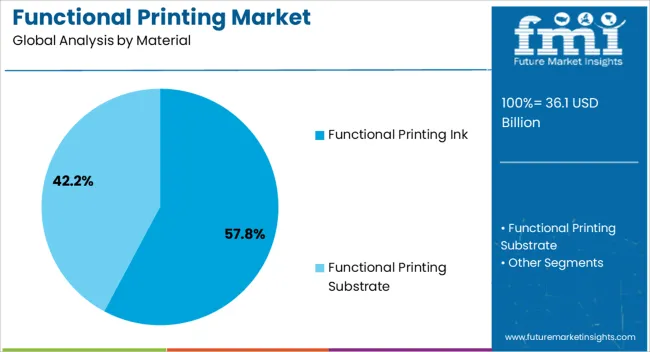
The functional printing ink material segment is projected to hold 57.8% of the functional printing market revenue share in 2025, making it the leading material category. Its dominance is being supported by the versatility and performance characteristics offered by specialized inks, including conductivity, flexibility, and adhesion to varied substrates. These inks are enabling precise deposition of functional patterns, which is critical for printed electronics, wearable sensors, and display applications.
The segment is being reinforced by ongoing research in nanomaterials, conductive polymers, and hybrid formulations that improve print quality and device reliability. Compatibility with multiple printing techniques allows manufacturers to reduce costs while achieving high throughput.
The ability of functional printing inks to integrate seamlessly with emerging technologies, including flexible displays and energy devices, further strengthens their market position As industries increasingly seek scalable, high-performance solutions, functional printing inks continue to be preferred for their adaptability, process efficiency, and alignment with sustainability initiatives.
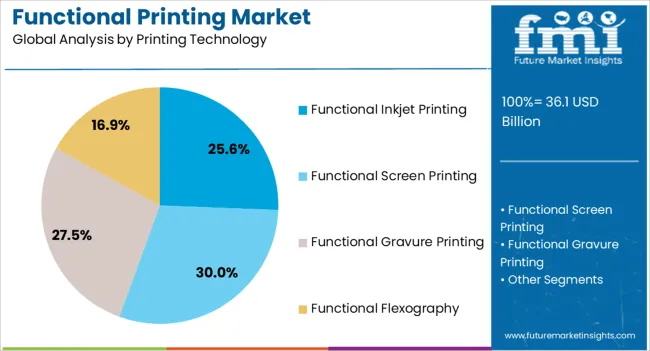
The functional inkjet printing technology segment is expected to capture 25.6% of the functional printing market revenue share in 2025, establishing it as the leading printing technology. This leadership is being driven by its precise droplet control, scalability, and ability to produce high-resolution functional patterns without requiring expensive masks or templates. The non-contact nature of inkjet printing reduces substrate damage, enhances material utilization, and supports flexible and three-dimensional applications.
The segment is being supported by growing adoption in industries such as electronics, healthcare, and smart packaging, where rapid prototyping and customization are critical. Continuous improvements in ink formulation, printhead design, and substrate compatibility are expanding the technology’s application scope.
Its cost-effectiveness, combined with high-resolution capability and minimal material wastage, is reinforcing adoption among manufacturers seeking efficient and reliable production processes The versatility and rapid adaptability of functional inkjet printing technology are expected to continue driving its market dominance in the functional printing landscape.
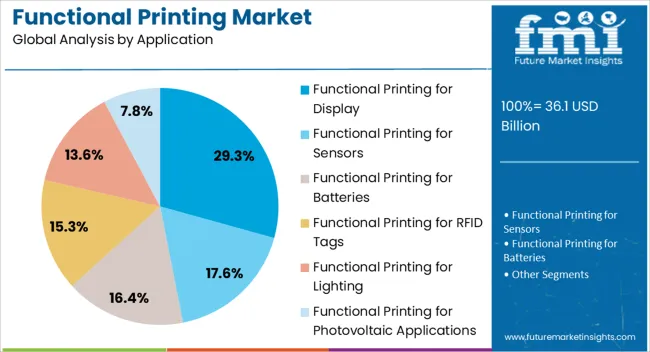
The functional printing for display application segment is projected to hold 29.3% of the functional printing market revenue share in 2025, making it the largest application category. Its leadership is being driven by the growing demand for advanced display technologies, including flexible, transparent, and wearable displays. Functional printing allows for precise deposition of conductive, emissive, and protective layers, enabling high-performance displays with reduced manufacturing complexity.
The segment is supported by the increasing adoption of printed electronics in consumer electronics, automotive panels, and smart devices. Ongoing advancements in printing techniques and material formulations are enhancing resolution, conductivity, and durability, which is critical for next-generation display applications.
Manufacturers are increasingly leveraging functional printing for displays due to its ability to scale production, reduce cost, and support innovative form factors Rising consumer demand for interactive, lightweight, and energy-efficient display technologies is expected to sustain segment growth and reinforce its position as a leading application in the functional printing market.
The functional printing market has been witnessing the convergence of several industry sectors such as printing, materials (substrate, inks, and chemicals), and electronics; which facilitates the development of new products, that is a factor anticipated to boost the growth of the Functional Printing Market.
Low-cost manufacturing process is expected to be one of the primary factors driving the Functional Printing market which in turn is expected to augment the demand for new substrates and inks over the next few years. The conventional high-volume-low-cost printing techniques enable the production of lightweight and robust electronic components at a lower cost; and this printing process does not involve etching, metalizing, and copper plating, thus eliminating the wastewater treatment. In addition, growth of the electronics and semiconductor market is expected to fuel the demand for functional printing market during the forecast period.
Further, there is a considerable development for the promising future of functional printing, an evolving technology that has the potential to enable what is seen as the next wave, in high-volume electronic production. Other significant factors that are fueling the growth of the functional printing market include lower energy consumption and material wastage, leading to a smaller impact on the environment, caused by the manufacturing of electronic devices.
Although functional printing has a wide application range, the global spread of COVID-19 has drastically impacted the functional printing sector. The rapid spread of the pandemic globally had initiated lockdowns in numerous nations, which lead to the disruption of supply chain activities and shutting down of several manufacturing plants. The slowdown precipitated in the manufacture of products using Functional Printing has severely impacted the growth of such industries. Thus, it is expected to hinder the market growth during the forecast period.
Moreover, limitations of the electrically functional inks currently used for functional printing pose as a restraint in the growth of this market. In addition, the rising need of high accuracy to gain desired outcome along with rising complexities in functional printing techniques are the factors that are expected to hamper the growth of the Functional printing market during the forecast period.
North America is considered to be a highly lucrative market for Functional Printing and its products, owing to the presence of most of the functional printing equipment & material manufacturers in the region. Moreover, due to the increasing demand of the near field communication along with adoption of advanced technology and prevalence of improved infrastructure, the region is expected to fuel the growth of the Functional Printing Market.
Further, the growth in the retail industry in North America is likely to accelerate the use of RFID tags, thereby fueling the market growth during the forecast period. RFID automates the tracking of merchandise throughout the retail supply chain, from the warehouse to the store floor, replacing the process of employees scanning products manually.
According to Future Market Insights, Asia Pacific region is expected to provide immense growth opportunities for Functional Printing market, with China and India expected to steer the bulk of all regional growth. Moreover, the Asia-Pacific is expected to boost the demand for the Functional printing products owing to the prevalence of multi prominent electronics companies in the region.
In addition, the other factors that are expected to accelerate the Asia-Pacific Functional Printing market include the significant growth in the consumer electronics industry coupled with the growing demand for sensors in wearable electronics, in emerging economies such as India and China.
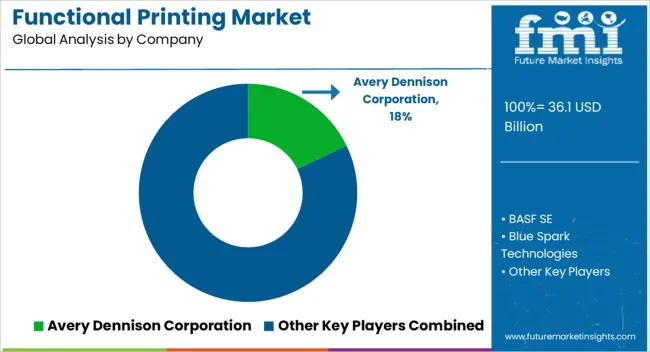
Some of the key participants present in the global Functional printing market include Avery Dennison Corporation, BASF SE, Blue Spark Technologies, E Ink Holdings Inc., Eastman Kodak Company Ltd., Enfucell Oy, GSI Technologies LLC, and Isorg among others.
Attributed to the presence of such high number of participants, the market is highly competitive. While global players such as Avery Dennison Corporation and BASF SE account for a considerable market size, several regional level players are also operating across key growth regions, particularly in the North America.
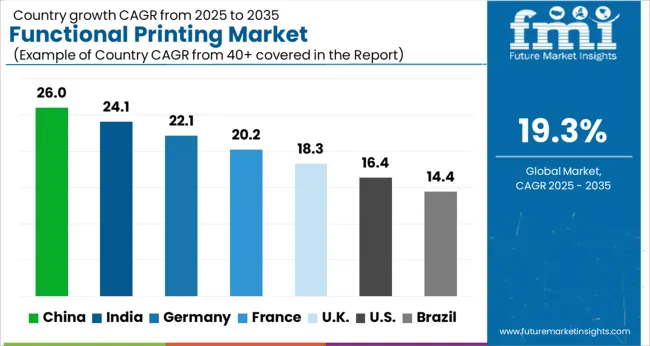
| Country | CAGR |
|---|---|
| China | 26.0% |
| India | 24.1% |
| Germany | 22.1% |
| France | 20.2% |
| UK | 18.3% |
| USA | 16.4% |
| Brazil | 14.4% |
The Functional Printing Market is expected to register a CAGR of 19.3% during the forecast period, exhibiting varied country level momentum. China leads with the highest CAGR of 26.0%, followed by India at 24.1%. Developed markets such as Germany, France, and the UK continue to expand steadily, while the USA is likely to grow at consistent rates. Brazil posts the lowest CAGR at 14.4%, yet still underscores a broadly positive trajectory for the global Functional Printing Market. In 2024, Germany held a dominant revenue in the Western Europe market and is expected to grow with a CAGR of 22.1%. The USA Functional Printing Market is estimated to be valued at USD 12.8 billion in 2025 and is anticipated to reach a valuation of USD 58.2 billion by 2035. Sales are projected to rise at a CAGR of 16.4% over the forecast period between 2025 and 2035. While Japan and South Korea markets are estimated to be valued at USD 2.0 billion and USD 1.2 billion respectively in 2025.
| Item | Value |
|---|---|
| Quantitative Units | USD 36.1 Billion |
| Material | Functional Printing Ink and Functional Printing Substrate |
| Printing Technology | Functional Inkjet Printing, Functional Screen Printing, Functional Gravure Printing, and Functional Flexography |
| Application | Functional Printing for Display, Functional Printing for Sensors, Functional Printing for Batteries, Functional Printing for RFID Tags, Functional Printing for Lighting, and Functional Printing for Photovoltaic Applications |
| Regions Covered | North America, Europe, Asia-Pacific, Latin America, Middle East & Africa |
| Country Covered | United States, Canada, Germany, France, United Kingdom, China, Japan, India, Brazil, South Africa |
| Key Companies Profiled | Avery Dennison Corporation, BASF SE, Blue Spark Technologies, E Ink Holdings Inc., Eastman Kodak Company Ltd., Enfucell Oy, GSI Technologies LLC, and Isorg |
The global functional printing market is estimated to be valued at USD 36.1 billion in 2025.
The market size for the functional printing market is projected to reach USD 210.3 billion by 2035.
The functional printing market is expected to grow at a 19.3% CAGR between 2025 and 2035.
The key product types in functional printing market are functional printing ink and functional printing substrate.
In terms of printing technology, functional inkjet printing segment to command 25.6% share in the functional printing market in 2025.






Our Research Products

The "Full Research Suite" delivers actionable market intel, deep dives on markets or technologies, so clients act faster, cut risk, and unlock growth.

The Leaderboard benchmarks and ranks top vendors, classifying them as Established Leaders, Leading Challengers, or Disruptors & Challengers.

Locates where complements amplify value and substitutes erode it, forecasting net impact by horizon

We deliver granular, decision-grade intel: market sizing, 5-year forecasts, pricing, adoption, usage, revenue, and operational KPIs—plus competitor tracking, regulation, and value chains—across 60 countries broadly.

Spot the shifts before they hit your P&L. We track inflection points, adoption curves, pricing moves, and ecosystem plays to show where demand is heading, why it is changing, and what to do next across high-growth markets and disruptive tech

Real-time reads of user behavior. We track shifting priorities, perceptions of today’s and next-gen services, and provider experience, then pace how fast tech moves from trial to adoption, blending buyer, consumer, and channel inputs with social signals (#WhySwitch, #UX).

Partner with our analyst team to build a custom report designed around your business priorities. From analysing market trends to assessing competitors or crafting bespoke datasets, we tailor insights to your needs.
Supplier Intelligence
Discovery & Profiling
Capacity & Footprint
Performance & Risk
Compliance & Governance
Commercial Readiness
Who Supplies Whom
Scorecards & Shortlists
Playbooks & Docs
Category Intelligence
Definition & Scope
Demand & Use Cases
Cost Drivers
Market Structure
Supply Chain Map
Trade & Policy
Operating Norms
Deliverables
Buyer Intelligence
Account Basics
Spend & Scope
Procurement Model
Vendor Requirements
Terms & Policies
Entry Strategy
Pain Points & Triggers
Outputs
Pricing Analysis
Benchmarks
Trends
Should-Cost
Indexation
Landed Cost
Commercial Terms
Deliverables
Brand Analysis
Positioning & Value Prop
Share & Presence
Customer Evidence
Go-to-Market
Digital & Reputation
Compliance & Trust
KPIs & Gaps
Outputs
Full Research Suite comprises of:
Market outlook & trends analysis
Interviews & case studies
Strategic recommendations
Vendor profiles & capabilities analysis
5-year forecasts
8 regions and 60+ country-level data splits
Market segment data splits
12 months of continuous data updates
DELIVERED AS:
PDF EXCEL ONLINE
Functional Multi-Layer Coextruded Film Market Size and Share Forecast Outlook 2025 to 2035
Printing Paper Market Size and Share Forecast Outlook 2025 to 2035
Functional Plating Chemicals Market Size and Share Forecast Outlook 2025 to 2035
Functional Flours Market Size and Share Forecast Outlook 2025 to 2035
Functional Flour Market Size and Share Forecast Outlook 2025 to 2035
Printing Machinery Market Size and Share Forecast Outlook 2025 to 2035
Functional Endoscopic Sinus Surgery Systems Market Size and Share Forecast Outlook 2025 to 2035
Functional Foods Market Size and Share Forecast Outlook 2025 to 2035
Functional Safety Market Size and Share Forecast Outlook 2025 to 2035
Functional Seafood Market Size and Share Forecast Outlook 2025 to 2035
Functional Textile Finishing Agents Market Size and Share Forecast Outlook 2025 to 2035
Functional Water Market Size and Share Forecast Outlook 2025 to 2035
Printing Toners Market Size and Share Forecast Outlook 2025 to 2035
Functional Pet Ingredients Market Analysis - Size, Share, and Forecast Outlook 2025 to 2035
Functional Cosmetic Ingredients Market Size and Share Forecast Outlook 2025 to 2035
Functional Food Ingredients Market Analysis – Size, Share, and Forecast Outlook 2025 to 2035
Functional Flavour Market Analysis - Size, Share, & Forecast Outlook 2025 to 2035
Functional Extracts Market Analysis – Size, Share, & Forecast Outlook 2025 to 2035
Functional Chewing Gum Market Analysis - Size, Share, & Forecast Outlook 2025 to 2035
Functional Carbohydrate Market Analysis -Size, Share, & Forecast Outlook 2025 to 2035

Thank you!
You will receive an email from our Business Development Manager. Please be sure to check your SPAM/JUNK folder too.
Chat With
MaRIA